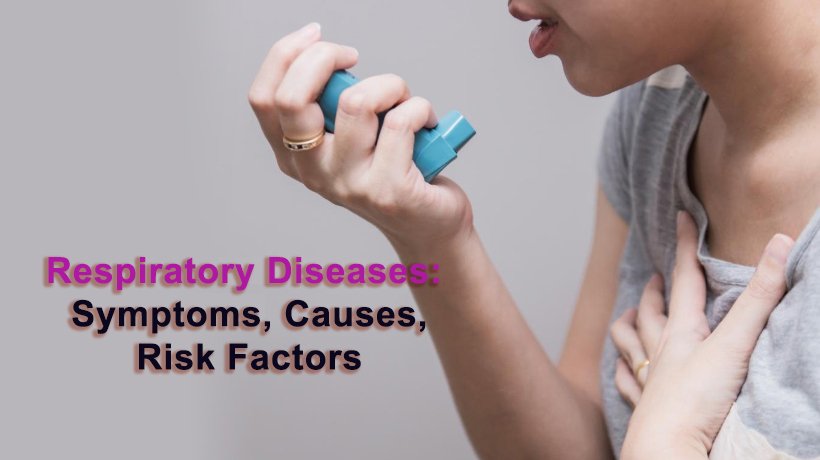Respiratory Diseases Conditions
Each minute, usually unconsciously, we breathe in and out between ten and fifteen times. We move enough air through our lungs to blow up several thousand balloons every day. In this way, the body extracts the oxygen it needs from the air, and discharges waste carbon dioxide from the blood. The vital job of delivering oxygen fuel to the body and removing carbon dioxide waste involves a close partnership between the Respiratory Diseases and circulatory systems. The actual point of contact between the two lies deep within the lungs, where airways and tiny blood vessels meet.
Air entering the nose and mouth travels down past the larynx (voice box), into the trachea (windpipe), through branching tubes called the bronchi and bronchioles, and into the lungs. There the airways further branch out into millions of thin-walled sacs called alveoli. Here, inhaled air comes in close contact with the webs of surrounding capillaries, allowing blood to exchange carbon dioxide for oxygen through diffusion. This oxygenated blood travels through the body via an elaborate network of interconnected vessels. Driving the system is the heart – a muscular, double-sided pump whose rhythmic contractions propel blood into the lungs and, through the aorta, to the rest of the body. Arteries continually carry blood away from the heart, and veins return to spent blood back to begin the cycle anew.
Oxygen is as vital to life as it provides fuel for all the body’s functions. The respiratory system also eliminates toxic waste, regulates temperature, and ensures the stability of the blood’s acid-alkaline balance.
Respiratory problems can be divided into three categories:
Infections of the upper and lower respiratory tract’ such as the common cold, sinusitis, pneumonia, and tuberculosis.
Chronic obstructive lung diseases, such as asthma, bronchitis, and emphysema.
And occupational/environmental-related lung conditions, such as hypersensitivity to work-site substances and air-pollution, or inhalation of particulate foreign matter, such as asbestos, fibers, coal dust, and stone dust (which causes silicosis).For more advice on the asbestos disease, as well as support, you can turn to Asbestos Awareness to make a compensation claim. It could take 15-60 years for symptoms to develop, but only a few minutes to fill out this form to be compensated for this.
Chronic obstructive diseases have multiple causes. The chronic inflammation of lung tissue that is characteristic of asthma, for example, can be brought on by pollen, irritants, or exercise. The destruction of lung tissue that results from emphysema may be caused by a hereditary enzyme deficiency as well as excessive smoking.
Prevention of Respiratory Diseases
In the nineteenth and early twentieth century’s, respiratory diseases provided one of the main exit scenarios for both old and young alike. People frequently died of pneumonia, tuberculosis, and influenza, all of which have been largely conquered. The respiratory system has been a site of major advances and success stories in modern medical science and is now a battleground of very bothersome diseases, but usually not fatal.
So, what do we need to be concerned about, then? Smokers are exposing themselves to the few lethal diseases that do attack the lungs: emphysema, which so weakens the lungs that they can no longer oxygenate the blood, and lung cancer. We are still relatively helpless in the face of allergies, but we are discovering more useful therapies. Asthma often set off by allergies, is another problem.
Worse, we are discovering new strains of old diseases, such as TB, that are resistant to the antibiotics in common use and can be only be treated by combinations of several extremely expensive synthetic drugs. (It is vital to curb the use of antibiotics, as overuse of these miracle drugs has caused many strains to become resistant to treatment)
Unless a fast-moving and lethal disease strike you, you may not be aware of any potential lung damage due to the body’s natural reserve system. Smokers, for example, may not notice any physical changes until they lose 50% of their lung capacity. Similarly, only extreme exposure to environmental toxins (such as asbestos) produces readily apparent differences in pulmonary and respiratory function.
Conscientious nonsmokers should take note that a poor diet can also produce lung disease. A recently published study shows that a diet high in saturated fats correlates with a higher risk of lung cancer among women who do not smoke, either actively or passively. (High levels of saturated fat in the diet correlate with other types of cancer as well.)
Health Tip For Treat Respiratory Diseases
There are different nutritional aspects of healthy lungs. Following is a list of supplements that support healthy epithelial tissue (which includes the tissue of the mouth, throat, and skin):
- Vitamin C: 1000 milligrams per day
- Vitamin E: 800 International Units per day
- Mixed carotenoids: 25,000 International Units per day
- Vitamin A (retinol): 25,000 International Units per day
- Selenium: 100 micrograms twice daily
- Zinc: 30 milligrams twice daily
- Folic Acid: 1 milligram twice daily
- Magnesium: 500 milligrams
Vitamin B Complex
Essential Fatty Acids: Omega- 3 (fish oils) Omega-6 (flaxseed oil, borage oil, black currant seed oil) 1000-3000 milligrams each.
Respiratory Diseases Infections
The idea of the respiratory tree explains the similarity of many respiratory diseases to one another. We can visualize the respiratory system as the upside-down tree, with roots as the sinuses, the trunk as the trachea or windpipe, the two main branches as the bronchi of the lungs, and the many smaller internal branches as the bronchioles of the lungs. These small internal branches bear the ‘leaves’ or alveoli, which are little air sacs where oxygen diffuses into the blood, and carbon dioxide diffuses out. In the normal adult, the total surface area of the lungs is huge: some 50 to 100 square meters, or about the floor area of a 25-foot by 30-foot room.
The surface tissue of the air passages and the lungs is all physically connected, from the sinuses to the bronchi to the inner lining of the lungs. Bacteria and viruses can easily travel from one part of the tree to another, spreading infection. Gravity can pull a postnasal drip of infectious material into the lungs, causing bronchial infection or pneumonia. Colds, flu, sinusitis, bronchitis, and pneumonia are thus interrelated and often infer causal.
Chronic mucus congestion can create the perfect trap and incubation environment for bacterial growth. The congestion keeps the mucous membranes inflamed, thereby reducing the local immune response. This explains how someone can have chronic sinusitis and asthma at the same time, both of which have allergic, infectious, and inflammatory components. The two most common respiratory infections are sinusitis and bronchitis.
Why Can’t We Cure a Common Cold?
The common cold and flu are still on the frontiers of medicine, right up there with some of the more severe illnesses. While there’s not a lot of funding for research into the common cold, incredible sums of money are spent on developing and advertising cold remedies, many of which are of limited or no value. Some conventional treatments may have long-term debilitating effects. Decongestants, whether oral or spray, can prolong the course of a viral infection by drying out these membranes.
Finally, our attitude toward antibiotics and respiratory infections are shifting. Over and over again, statistical analyses of various treatments and therapies show that conservative management, or simply doing nothing, correlates with a long-term health outcome that’s as good as or better than more invasive treatments. Antibiotic therapy runs the risk of creating yeast infections, diarrhea, rashes, allergic problems, and increasing resistance to antibiotics. For instance, simple bed rest can be a powerful tool against all kinds of respiratory infections and can sometimes give better results without lingering side effects than other medical treatments.
Symptoms of Asthma
Asthma has been around for a long time. Therefore, with the inexorable march of medical progress, we should be steadily advancing toward the eradication of the disease. Wrong. The number of North Americans with asthma increased 60% over the years 1983 to 1993. The asthma death rate has increased from less than 2000 per year in the United States in 1978 to more than 4500 per year in 1993. The cost of treating asthma patients in the United States was estimated to be $6.42 billion in 1990. This trend is increasing worldwide, with statistics showing that asthma is getting worse precisely in those countries that should have the best medical care: Canada, the United States, Australia, and New Zealand.
Some might surmise that it is our worsening air quality that is responsible for the increases in asthma incidence and death. Yet, statistics indicate that because of the Clean Air Act, the levels of air pollution in our major metropolitan areas are declining. So while air pollution and chemical exposure play a significant role in asthma, we can’t conclude that the increase in asthma problems is due simply to deteriorating air quality. Some argue that smoking is responsible for our worsening asthma statistics. But here, too, research indicates that the number of smokers is declining overall, despite still-high smoking levels among teenagers and young women.
The increase in asthma statistics has remained a curious puzzle without apparent cause – until recently. Research scientists now think they have an answer to the mystery, and that answer strikes directly at the heart of modern medicine and the type of therapies doctors commonly choose. The mainstay of asthma therapy is the use of inhaled bronchodilator medications, which are designed to open constricted lung tubules. Indeed, most people with asthma welcome the temporary relief these inhalers give.
People with asthma, however, know the side effects of bronchodilator use. Puffing again and again on their inhalers to obtain relief, they note rapid heartbeat, tremor, and anxiety. Parents of children with asthma often claim that their children exhibit hyperactivity and decreased attention span. The intriguing answer to the riddle of increased asthma incidence and death may lie in a recent article in The Lancet, Britain’s most respected medical journal. The authors of this study looked at eighty-nine persons with moderate asthma. They compared the use of bronchodilators in people who used inhalers only for the relief of symptoms, versus those who used the inhalers routinely. Surprisingly, the less frequently the medication was used, the better the asthma symptoms were controlled.
The fact is that the medical profession, by its admission, is facing a crisis in the management of asthma. While mainstream medicine continues to try out new pharmaceutical agents, perhaps with new unpredictable side effects, it is worth surveying the wide assortment of alternative therapies that may show promise in the treatment of asthma.
A Look to the Future
The prognosis for respiratory health continues to look brighter as we project current trends into the twenty-first century. Lung cancer and emphysema rates will go down as smoking eventually dies away as a social custom. With that culprit greatly eliminated, we can expect to increase our awareness of the multiple causative factors in sinus and lung problems and to reduce the occupational and environmental hazards that can cause respiratory problems.
We are also shifting from a drug-based approach to a green approach, or an ecological approach, to treating allergies and asthma. As evidence emerges showing the crossovers between food and respiratory reactions, we will make advances through diet modification. We will continue to discover and improve on nutritional, herbal, and other therapies that use the body’s own metabolic and cleansing processes, rather than powerful drugs, to correct and ease respiratory problems.












2 thoughts on “Respiratory Diseases: Symptoms, Causes, Risk Factors”
Comments are closed.